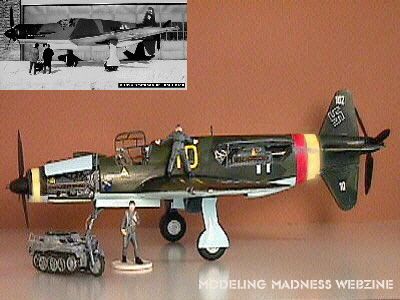
Kit: Monogram 1/48 Do-335 Dornier "Pfeil - Arrow" (unofficial, "Ameisenbar- Anteater")
Price: $10-12 ? (1974)
Decals: Three versions; two day-fighter, one night-fighter
Review and Photo by Bob Swift

This kit appeared at a time (1974) when Monogram was riding the crest of the wave, and blowing away the competition. No other company in this field could offer the quality, detail, and sometime accuracy embodied in a Monogram aircraft kit. I bought the kit within a day or so of its release, and remember how impressed I was when I opened the box and looked inside. The kit was placed on the 'to do' pile, but shortly thereafter was packed away in storage where it remained until resurrected in 1998.
The concept for this unique aircraft was patented by Dr. Claude Dornier in 1937. By 1940 a small, scale test airframe had been constructed and was flown, powered by an 80 hp engine, to develop data on the effects created by a pusher airscrew behind a cruciform tail driven by an extension shaft. Testing proved the arrangement to be viable, and a design was initiated on a full scale aircraft to fill the bomber/intruder role. While it wasn't fully developed, it did eventually lead to the design of the Do-335 in 1942. The prototype flew in the autumn of 1943, powered by two BB603E engines rated at 1800 hp each. Of thirty-eight aircraft ordered, fourteen were designated as experimental machines. There were a number of variations envisioned; from a two seat night-fighter, to a high altitude bomber destroyer. By the end of the war only a few examples had actually reached Luftwaffe units, and no operational combat encounters have been recorded. Armament on the model depicted was one 30mm, Mk 103 cannon, firing through the forward airscrew hub, and two 15mm, Mk 151 cannon in the upper decking. Provision was also made for an 1100 lb. bomb load. Engines at this point of development were DB603G's, rated at 1900 hp, each.
The instruction sheet is well drawn and easy to follow. The kit is molded in dark green plastic with panel lines, rivets, etc. being raised; even so, the detail is very good and crisply rendered. The kit can be built in one of two versions; a single cockpit day-fighter, or a twin cockpit night-fighter complete with second cockpit and external radar array. The array is nicely done with the full complement of 'antlers', but as with most models of this era, the components are out of scale, and look 'klunky' when assembled. Two upper fuselage segments are offered, and added according to the version being built. We chose to build the day-fighter version, but either way, it would have been problematic, since the fit of these two pieces to the main fuselage leaves much to be desired. I'm sure this is due to the considerable warp of the larger segments which could not be completely eliminated. Cockpit detail is excellent, and worth keeping the 'lid' open so it can be displayed. The second cockpit is equally well detailed; unfortunately, canopies, while well molded and quite clear, are much too thick; we kept the canopy open, anyway. Detail in both engine compartments, including the drive shaft in the rear section, are worth the effort to finish; almost a 'must', since the doors to these compartments just don't look right in the closed position. Like the canopies, the doors are too thick, as well. So, take your pick.
Landing gear wells are boxed for the main gear, and the nose gear well is a separate sub-assembly with some nicely molded detail. A little fender is supplied for the nose wheel and adds a nice touch to that area. The gear itself is well done and sturdy enough to permit weight addition to the front end to make it sit on the nose gear, rather than gluing the little plastic stick Monogram included to the lower tail assembly. Definitely a tail sitter, and it requires considerable weight to get the front end down. We only had modeling clay available at the time; fortunately the inside-front area is cavernous with plenty of space to use for this purpose. Best to do this before joining fuselage halves; small increments can be added later, carefully and as needed, through the cockpit opening. Moderate filling/sanding is required in the usual places; i.e., wing/fuselage joints, and upper fuselage piece where it joins the main segment.
Painting instructions are not too informative; use light green, and dark green over light blue. We chose the two greens in vogue from the late war period offered by Model Master; finished with satin clear from Poly-S. Decals were in bad shape from age; current stock offerings of crosses and swastikas from Microscale were used, and where necessary, liquid decal film was used to salvage items from the original kit sheet that aren't available, otherwise.
This was a big, ugly airplane, and it really looks impressive on the shelf next to its contemporaries. It was fun to build, and overall, a pretty nice effort on Monogram's part. Let's see, I think there's a box in the big carton with Monogram's Ju-87 and the neat cannon on the landing gear spats; hmmm!
Copyright ModelingMadness.com. All rights reserved.
Back to Reviews Page 2020